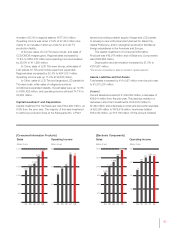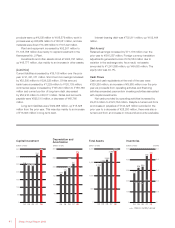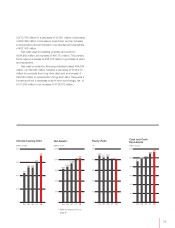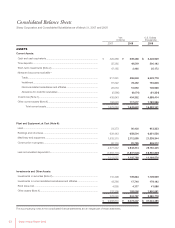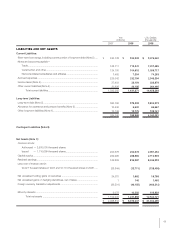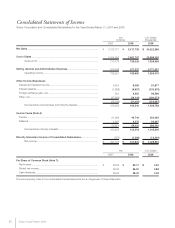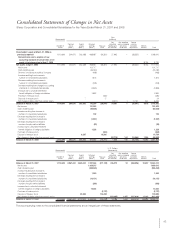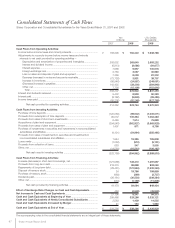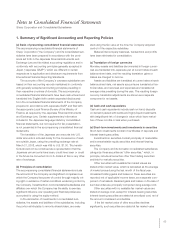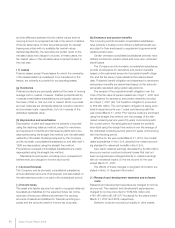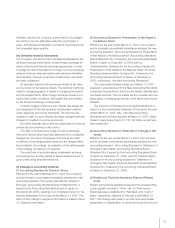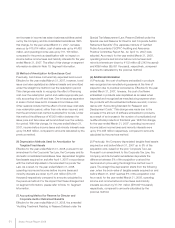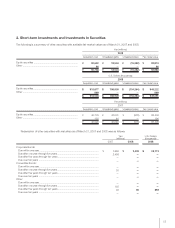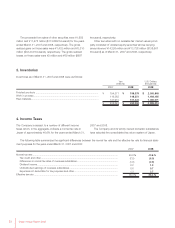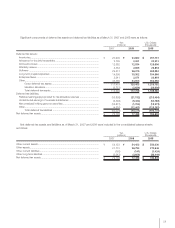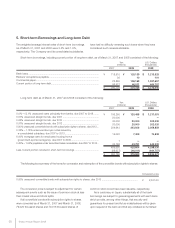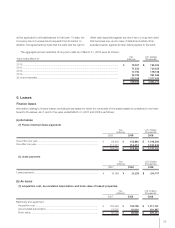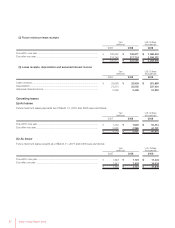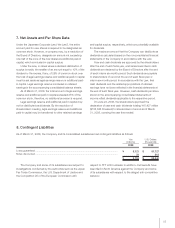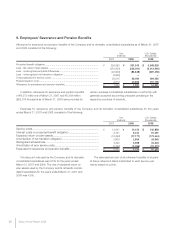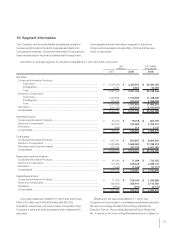Sharp 2008 Annual Report Download - page 51
Download and view the complete annual report
Please find page 51 of the 2008 Sharp annual report below. You can navigate through the pages in the report by either clicking on the pages listed below, or by using the keyword search tool below to find specific information within the annual report.
50
Software used by the Company is amortized by the straight-
line method over the estimated useful life of principally 5
years, and software embedded in products is amortized over
the forecasted sales quantity.
(m) Derivative financial instruments
The Company and some of its consolidated subsidiaries use
derivative financial instruments, include foreign exchange for-
ward contracts and interest rate swap agreements, in order
to hedge the risk of fluctuations in foreign currency exchange
rates and interest rates associated with assets and liabilities
denominated in foreign currencies, investments in securities
and debt obligations.
All derivative financial instruments are stated at fair value
and recorded on the balance sheets. The deferred method is
used for recognizing gains or losses on hedging instruments
and the hedged items. When foreign exchange forward con-
tracts meet certain conditions, the hedged items are stated
by the forward exchange contract rates.
If certain hedging criteria are met, interest rate swaps are
not recognized at their fair values as an alternative method
under Japanese accounting standards. The net amounts
received or paid for such interest rate swap arrangements are
charged or credited to income as incurred.
Derivative financial instruments are used based on internal
policies and procedures on risk control.
The risks of fluctuations in foreign currency exchange
rates and interest rates have been assumed to be completely
hedged over the period of hedging contracts as the major
conditions of the hedging instruments and the hedged items
are consistent. Accordingly, an evaluation of the effectiveness
of the hedging contracts is not required.
The credit risk of such derivatives is assessed as being
low because the counter-parties of these transactions are of
good credit rating financial institutions.
(n) Changes in accounting methods
(1) Accounting Standard for Directors’ Bonus
Effective for the year ended March 31, 2007, the Company
and its domestic consolidated subsidiaries adopted the new
accounting standard “Accounting Standard for Directors’
Bonuses” (Accounting Standards Board Statement No. 4
issued by the Accounting Standards Board of Japan on
November 29, 2005), resulting in an immaterial impact on the
financial statements for the year ended March 31, 2007. The
effect of this change on segment information is stated in Note
10. Segment Information.
(2) Accounting Standard for Presentation of Net Assets in
the Balance Sheet
Effective for the year ended March 31, 2007, the Company
and its domestic consolidated subsidiaries adopted the new
accounting standard, “Accounting Standard for Presentation
of Net Assets in the Balance Sheet” (Accounting Standards
Board Statement No. 5 issued by the Accounting Standards
Board of Japan on December 9, 2005) and the
“Implementation Guidance for the Accounting Standard for
Presentation of Net Assets in the Balance Sheet” (Financial
Standards Implementation Guidance No. 8 issued by the
Accounting Standards Board of Japan on December 9,
2005), (collectively, “the New Accounting Standards”).
The consolidated balance sheet as of March 31, 2007
prepared in accordance with the New Accounting Standards
comprises three sections, which are the assets, liabilities and
net assets sections. The net assets section includes net unre-
alized gains on hedging derivatives, net of taxes and minority
interests.
The adoption of the New Accounting Standards had no
impact on the consolidated statement of income for the year
ended March 31, 2007. Also, if the New Accounting
Standards had not been adopted at March 31, 2007, share-
holders’ equity amounting to ¥1,183,126 million would have
been presented.
(3) Accounting Standard for Statement of Changes in Net
Assets
Effective for the year ended March 31, 2007, the Company
and its domestic consolidated subsidiaries adopted the new
accounting standard, “Accounting Standard for Statement of
Changes in Net Assets” (Accounting Standards Board
Statement No. 6 issued by the Accounting Standards Board
of Japan on December 27, 2005), and the “Implementation
Guidance for the Accounting Standard for Statement of
Changes in Net Assets” (Financial Standards Implementation
Guidance No. 9 issued by the Accounting Standards Board
of Japan on December 27, 2005).
(4) Royalty and Technical Assistance Fees and Related
Costs
Royalty and technical assistance fees and the corresponding
costs originally included in “Other, net” of Other Income
(Expenses) were reclassified into “Net sales” and “Cost of
sales,” respectively, effective for the year ended March 31,
2007. This change was made to provide more appropriate
presentation or classification of income and cost since the cur-


